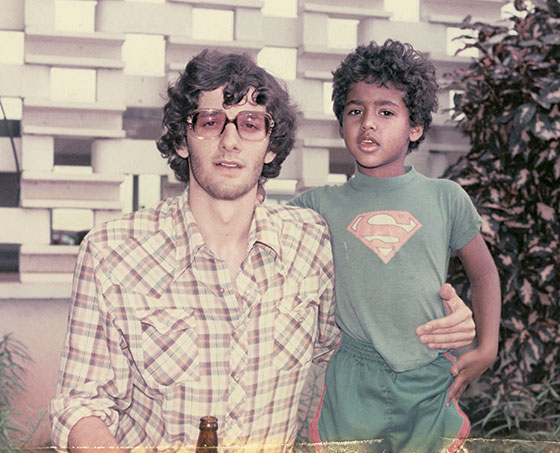 |
Martin with son Eli in Nigeria in 1981, immediately after taking the bar exam.
(Photo: Courtesy of Martine Rothblatt) |
In 1990, the family was on vacation in Telluride, and Jenesis, the youngest child, was unable to keep up. “I was always lagging behind,” she says. She was 7 years old and turned blue with effort. Back home in Silver Spring, Jenesis was diagnosed with a rare, fatal disease then called primary pulmonary hypertension, which constricts the blood flow in the arteries between the heart and the lungs. Jenesis fainted a lot, and when it was time for bed, one of her parents had to carry her upstairs to her room.
There is still no cure, and around the time of Jenesis’s diagnosis, there was almost nothing on the market in the way of drug therapies, either. Most sufferers died within two years. The best was something called Flolan, made by Glaxo, which had to be administered intravenously, 24 hours a day, through a portable pump. “I thought, Wow, that doesn’t sound very good,” Martine said.
It was Jenesis who suggested that Martine take action—Jenesis who knew with her child’s mind that her father seemed to regard every obstacle as a dare. Sirius had gone public in 1994, and Martine had gotten richer. But she was also a little lost. “Martine was going through her transition and had been kind of considering retiring,” said Jenesis. “I can remember crying myself to sleep many a night, thinking, I don’t want to die. I remember thinking, If you’re going to be around the house all the time, then maybe you can do something to help me.”
Martine sold a chunk of her Sirius shares and with $3 million created the PPH Cure foundation. She also took herself to school, traveling regularly to the National Institutes of Health and to the Library of Congress; Jenesis, who was being home-schooled at the time, often accompanied her. This odd couple, a father who was becoming a woman and a daughter with a fatal disease, would sit side by side in the nation’s libraries, reading science-journal articles about pulmonary conditions. For homework, Martine would make Jenesis write reports about what she’d learned.
At UT there’s a saying that Martine likes a lot: “Identify the corridors of indifference and run like hell down them.” In 1996, Martine found a retired pharmacologist named James Crow, who had supervised the development of Flolan. She called him incessantly, and when she finally reached him, she insisted on an in-person meeting. Crow said he’d be free in about two months, but Martine refused to be put off. “ ‘No,’ she said, ‘I’ve already got your ticket. I want to meet you in D.C.,’ ” Crow remembered her saying. “ ‘At The Four Seasons. On Thursday.’ ”
Crow told Martine about a drug that was sitting on the shelf—a safer, more convenient treatment than Flolan. But Glaxo had no interest in producing a second drug—the market was too small. Martine saw her chance; as the parent of a suffering child, she understood how desperate those patients were for even incremental improvements in quality of life. And, in pharma, desperation is the road to profit.
Martine, the satellite lawyer, made herself the CEO of this new pharma company and persuaded Crow to come out of retirement to serve as the president and COO; she gave each of them starting salaries of $75,000 a year. The plan was to license the drug, find investors, and then get FDA approval. The endgame was to make a pill to treat Jenesis’s disease, for, as Martine told me over tea in Burlington, “in the pharmaceutical industry, pills are sort of king.” Besides, she added, Jenesis did not want to be on a pump.
Raising money from her friends was easy. Martine’s transgendered status may even have been an asset, for it burnished her status as self-made, a pioneer. Patricia Kluge, the former wife of the late media billionaire John Kluge, was a friend of Martine’s at the time and says the subject of her gender never came up: “Bright people don’t talk about these things,” she told me. “The body is but a shell. It’s the mind and the heart that count.”
United Therapeutics went public in 1999, trading at $12 a share. Last year, after two failed attempts, Martine finally got FDA approval for the drug in a pill form, and on that news the stock increased by more than 50 percent over the next year, to $112 a share. UT is still a small company—with a staff of 729 and a $5.34 billion valuation, it is nowhere near the Fortune 500—but Martine retains ownership of 7.5 percent of it, an unusually large stake for a CEO. And she had earlier linked her salary to the company stock price, a sort of self-incentivization that explains her $38 million payday. There is still no cure for pulmonary hypertension, but with combinations of drugs from UT and other companies, patients can live longer than before. Jenesis turns 30 this year and works for her dad—as UT’s “senior manager of telepresence and visual signage.” But she is not the one responsible for issuing the company’s annual report in the form of a printed tablecloth; the previous year it came as a children’s book in the style of Goodnight Moon.